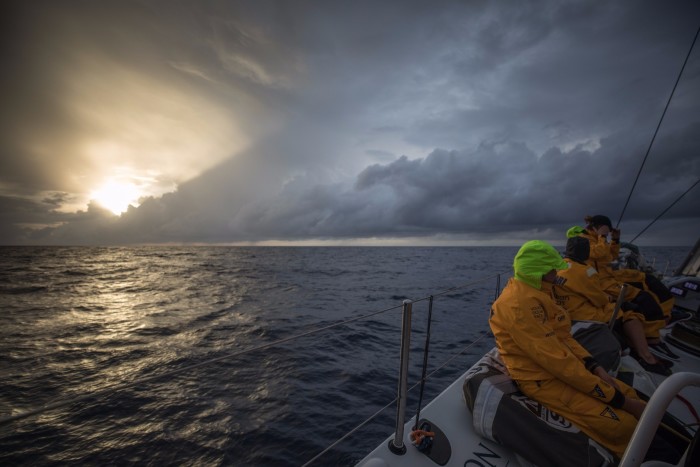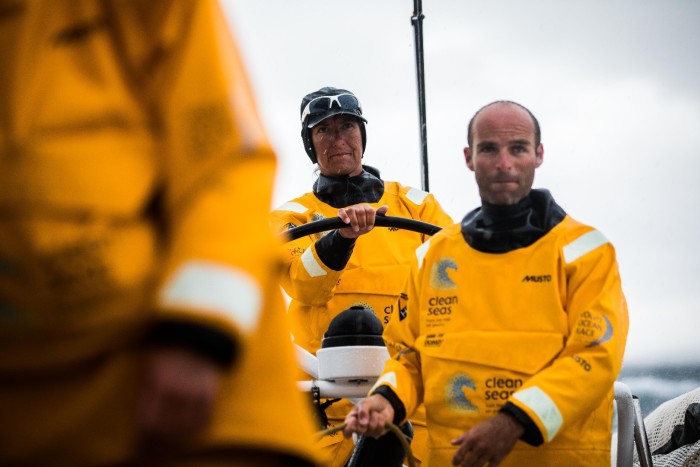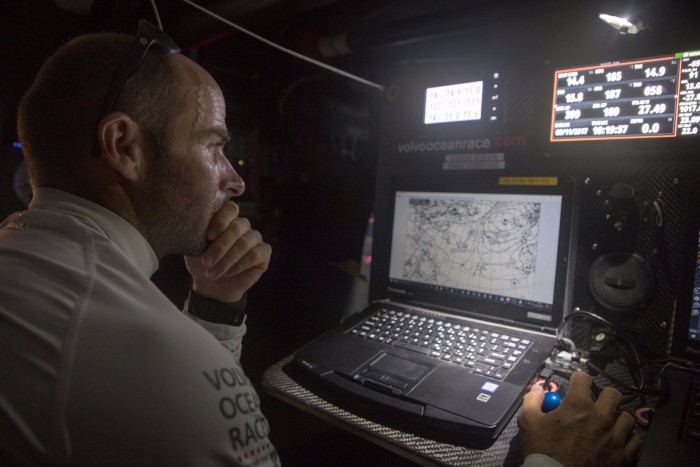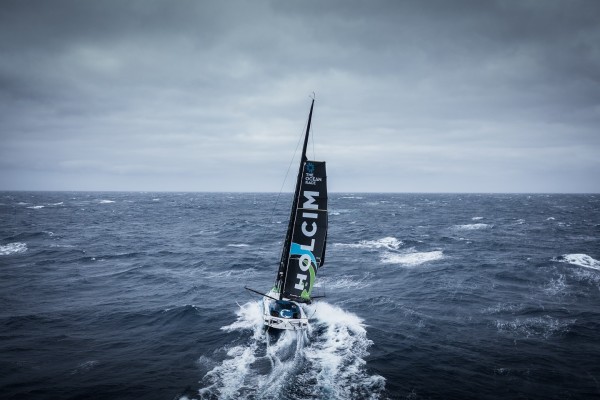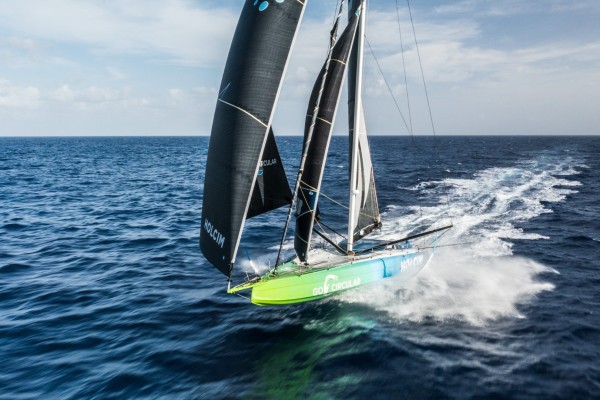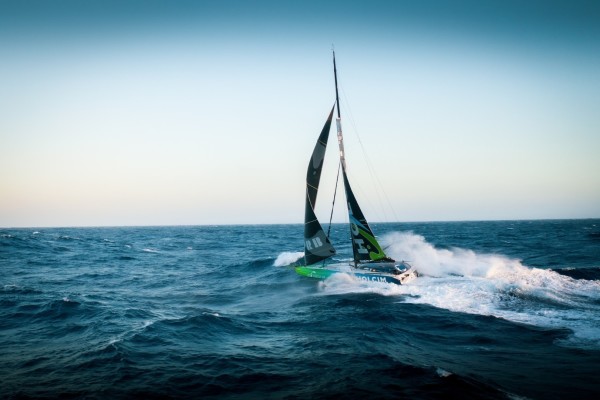Volvo Ocean Race
One leg aboard Turn The Tide On Plastic
The on-board organisation
In this particular leg, we had the rather special feature aboard Turn The Tide On Plastic of having two navigators: Brian Thompson and myself. It proved to be very interesting as it was a complicated leg, in an area we’re not very familiar with, where there are multiple weather systems to negotiate: monsoon in the China Sea, trade winds of the northern hemisphere, doldrums, trade winds of the southern hemisphere and finally a temperate westerly air flow to colour the end of the course as we neared New Zealand. This leg could also be transformed into a zig-zagging frenzy amidst the countless atolls and other archipelagos. It’s frightening even! We spent hours before the start of the leg preparing an Adrena Roadbook to locate all the little islands, which are poorly marked on the cartography sometimes!
Having two navigators aboard enabled us to get a lot done. Firstly, we were able to exchange ideas and compare our points of view. We fairly quickly realised that we complement each other and it was all done with good humour. It has to be said that Brian, who I didn’t know very well prior to this leg and had never sailed with him before, is someone very competent, really very nice and always good humoured. To the extent that you wonder if he’s actually English!
Moreover, having two of us aboard enabled us to be fully functioning the entire time and on the look-out at certain critical moments. Whilst one of us was sleeping, the other stayed watching the satellite images, the radar and the other competitors on the AIS, as well as keeping an eye on the squalls with the binoculars or the hand bearing compass. In fact, we traversed a vast zone around the equator where the water is very warm (30°C) and that, coupled with the humidity of the air, quickly encouraged vertical convection and the development of squalls or even storms, which can be very violent. Knowing how to exploit them or avoid them at appropriate times enables you to make significant gains.
The challenges of AIS
AIS is often a topic for debate since it became compulsory for transmitting and receiving. In fact, together with Brian, as soon as we were in contact with another boat (we pick them up from around 7-8 miles away), we were tracking them constantly. With tools like Adrena and WindBag +, an Excel history, we can scrutinise our rivals in terms of speed, course and change of trajectory. In the doldrums, the AIS enabled us to understand how a squall was evolving and the nature of the windless tail end of this system, etc.
In addition to this, the primary role of the AIS is fulfilled, which is to prevent collisions at sea. It’s worth noting that the shipping is incredibly dense where we were in the China Sea and around Taiwan. Commercial vessels (cargo ships and tankers) generally boast a very stable speed and course, so it’s easy to anticipate where we’ll pass one another. In contrast, fishermen often have variable speeds and make a number of course changes…
Furthermore, the smallest fishing vessels rarely have AIS. Some don’t even have their lights switched on! One night, we were just a few boat lengths away from a fisherman. We saw him thanks to his work lights or head torch! Without looking to take sides, something I couldn’t do in any case as I don’t know all the details, I have a slightly better understanding of how the terrible incident occurred between Vestas and a fishing boat on the approach to Hong Kong in the fourth leg. I had the opportunity to chat in Hong Kong with some people who do a fair amount of sailing in the area and they confirmed that small craft can come in any guise: from having lights in order to nothing at all, to lights with no colour match whatsoever or even fairy lights!
A mysterious encounter
One fine day when we were reaching in fifteen knots or so of breeze, we spotted a boat, its sails lowered, just drifting. Our course took us right beside this ghost ship. The boat was dipping its head a bit so there was probably some water up forward, but despite that it was still floating well. We tried, unsuccessfully, to hail the crew over the VHF. Our OnBoard Reporter (James Blake, son of the famous Sir Peter Blake) sent his drone over to take a closer look and took a few photos.
It was a strange moment aboard Turn The Tide On Plastic. What should we do? Should we stop to take a look aboard? At that point everyone started thinking about the story in the previous Clipper Race where a crew made a similar encounter and found a corpse inside a boat. As such, no one on-board was very enthusiastic about this idea…
After analysing the photos and getting in contact with Race Management to find out how best to proceed, it turned out that we’d crossed paths with Sea Nymph, whose crew were rescued last October some 900 miles to the South-East of Japan (ref. article in Voiles et Voiliers magazine back in December).

One might wonder, as the article in Voiles et Voiliers suggests, whether it was appropriate to abandon a ship, which is still afloat after months of drifting around with the rig and sails still seemingly in working order… Particularly given that this boat is still drifting about today and is a danger to shipping. Following our encounter, the MRCC (Maritime Rescue Coordination Centre) is now aware of the boat’s last known position.

Hurricane Gita
Throughout the entire leg we had some very mild conditions. Even the doldrums were kind to us as we were able to make a bit of headway throughout and, in the end, we didn’t have many storms and none of them were very violent.
However, a few days earlier and the end of the leg could have been more complicated. Indeed, Hurricane Gita rolled through a few days ahead of us. Rather than dishing out a lengthy speech, I’ll simply leave you to ‘admire’ the synoptic chart analysis from the Fiji Islands’ meteorological service along with the corresponding satellite image.


A leg finish worthy of the Solitaire du Figaro
After jockeying for the top three spots throughout the leg, it culminated in a finish worthy of a Solitaire du Figaro leg. The light breeze along the coast of New Zealand notably enabled Mapfre and Dongfeng to catch up with us, whilst they’d lamented a 150-mile deficit the day before! As a result, some 100 miles from the finish, the top five competitors compressed right down. Failing to deliver and hindered by a poor sail choice further down the track, we lost some ground and finally ended up fifth, 27 minutes off the top spot. It was obviously a major disappointment when we’d been battling for the podium for three weeks, but we did feel a sense of satisfaction at having made progress and sailed well against the very top-level crews. Indeed, the finish was still magical, with hundreds of boats out to greet us on the water in the middle of the night!
Volvo Ocean Race 2017-2018
Overall ranking after six legs
1. MAPFRE, 39 points
2. Dongfeng Race Team, 34 points
3. Team Sun Hung Kai/Scallywag, 26 points
4. Team AkzoNobel, 23 points
5. Vestas 11th Hour Racing, 23 points
6. Team Brunel, 20 points
7. Turn the Tide on Plastic, 12 points
The start of the 7th leg between Auckland (New Zealand) and Itajaí (Brazil) will set sail on Sunday 18 March 2018.

